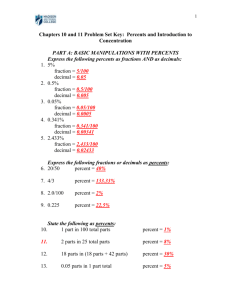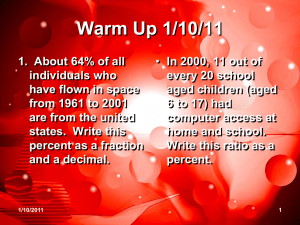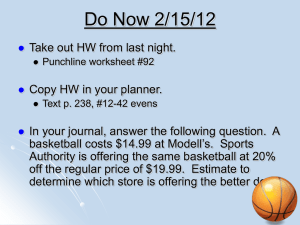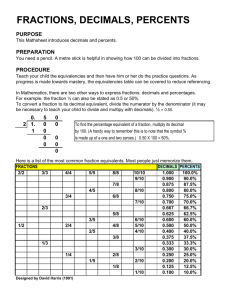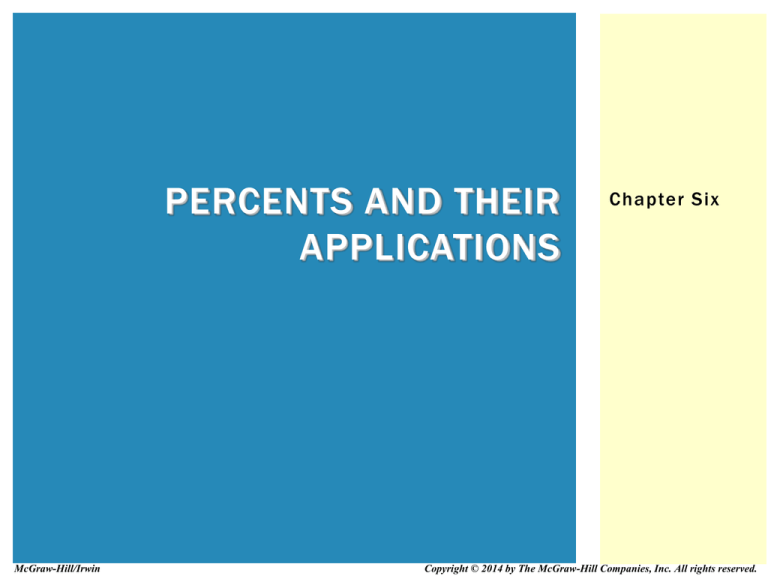
PERCENTS AND THEIR
APPLICATIONS
McGraw-Hill/Irwin
Chapter Six
Copyright © 2014 by The McGraw-Hill Companies, Inc. All rights reserved.
LEARNING UNIT OBJECTIVES
LU 6-1: Conversions
1.
Conver t decimals to percents (including rounding
percents), percents to decimals, and fractions to
percents.
Conver t percents to fractions.
LU 6-2: Application of Percents—Por tion Formula
2.
1.
List and define the key elements of the por tion formula.
2.
Solve for one unknown of the por tion formula when the
other two key elements are given.
3.
Calculate the rate of percent decreases and increases.
6-2
TABLE 6.1 - BAG OF M&M’S
Color
Yellow
Red
Blue
Orange
Brown
Green
Total
Fraction
18
55
10
55
9
55
7
55
6
55
5
55
55
55 = 1
Decimal
(hundredth)
Percent
(hundredth)
.33
32.73%
.18
18.18%
.16
16.36%
.13
12.73%
.11
10.91%
.09
9.09%
1.00
100.00%
6-3
CONVERTING DECIMALS TO
PERCENTS
Step 1. Move decimal point 2 places to the right. You are
multiplying by 100. If necessary, add zeros.
Step 2. Add a percent symbol at the end of the number.
66 %
.66
Step 1
Step 2
800 %
8
Step 1
Step 2
6-4
ROUNDING PERCENTS
Step 1. When you convert from a fraction or decimal, be sure
your answer is in percent before rounding.
Step 2. Identify the specific digit. If the digit to the right of the
identified digit is 5 or greater, round the identified digit.
Step 3. Delete digits to the right of the identified digit.
1 %
17
.0588235
.0588235
5.88%
6-5
ROUNDING PERCENTS
18
55
.3272727
32.73727%
32.73%
6-6
CONVERTING PERCENTS TO DECIMALS
Step 1. Drop the percent symbol.
Step 2. Move decimal point 2 places to the left. You
are dividing by 100. If necessary, add zeros.
66%
824.4%
66
824.4
.66
8.244
6-7
CONVERTING FRACTIONAL PERCENTS
TO DECIMALS
Step 1. Convert a single fraction percent to its decimal equivalent by
dividing the numerator by the denominator.
Step 2. If a fractional percent is combined with a whole number
(mixed fractional percent) convert the fractional percent first.
Then combine the whole number and the fractional percent.
Step 3. Drop the percent symbol; move the decimal point two places
to the left (this divides the number by 100).
1%
4
1/4 =
.0025
.25
7 3%
31 / 4 =
4
07.75
.0775
6-8
CONVERTING FRACTIONS TO
PERCENTS
Step 1. Divide the numerator by the denominator to
convert the fraction to a decimal.
Step 2. Move decimal point 2 places to the right; add
the percent symbol.
3
4
75%
3/4 =
.75
1
5
1/5 =
20%
.20
6-9
CONVERTING A WHOLE PERCENT (OR A
FRACTIONAL PERCENT) TO A FRACTION
Step 1. Drop the percent symbol.
Step 2. Multiply the number by 1/100.
Step 3. Reduce to lowest terms.
156%
156
156 X 1 /100 =
156
100
1%
8
1
8
1
8
= 1 56
100
X
1 /100 =
14
1 25
1
800
6-10
CONVERTING PERCENTS
TO DECIMALS
Step 1. Drop the percent symbol.
Step 2. Change the mixed percent to an improper fraction.
Step 3. Multiply the number by 1/100.
Step 4. Reduce to lowest terms.
Note: If you have a mixed or decimal percent, change the decimal
portion to fractional equivalent and continue with Steps 1 to 4.
1
12 % =
2
25 X 1
100 =
2
1
8
25 =
200
12.5% =
12
1
% = 25
2
1 =
X
2
100
25
200
=
1
8
6-11
SOLVE PERCENTS WITH THE PORTION
FORMULA
When solving
problems involving
portion, base, or rate,
you must give two of
these elements.
Portion (P) = Base (B)
x Rate (R)
6-12
SOLVING FOR PORTION
Sales of Milk Chocolate M&M’s® are 80% of total M&M’s®
sales. Total M&M’s® sales are $400,000. What are the
sales of Milk Chocolate M&M’s®?
Portion (P) = Base (B) x Rate (R)
P = $400,000 x .80
P = $320,000
6-13
SOLVING FOR BASE
Sales of Peanut and other M&M’s® chocolate candies are 20% of
total M&M’s® sales. Sales of Milk Chocolate M&M’s® sales are
$320,000. What are the total sales of all M&M’s®?
Base =
Portion
Rate
320,000 is 80% of
base (1.00 - .20)
Base = $320,000
.80
B = $400,000
6-14
SOLVING FOR RATE
Sales of Milk Chocolate M&M’s® are $320,000. Total
M&M’s® sales are $400,000. What is the percent of Milk
Chocolate M&M’s® sales compared to total M&M’s® sales?
Rate =
Portion
Base
Rate = $320, 000
$400,000
R = 80%
6-15
CALCULATING PERCENT DECREASES
AND INCREASES
Step 1. Find the difference between
amounts (such as advertising costs).
Step 2. Divide step 1 by the original amount
(the base): R = P / B. Be sure to
express your answer in percent.
6-16
RATE OF PERCENT INCREASE
Sheila Leary went to her local supermarket and bought a bag of
M&M’s®. The bag gave its weight as 18.40 ounces, which was 15% more
than a regular 1-pound bag of M&M’s®. Sheila, who is a careful shopper,
wanted to check and see if she was actually getting a 15% increase.
Rate = Portion
Base
Difference between old and new amount
Old amount
Rate = 2.40 oz
16.00 oz
Rate = .15 or 15% increase
6-17
RATE OF PERCENT DECREASE
The increase in the price of sugar caused the M&M/Mars company to
decrease the weight of each 1-pound bag of M&M’s® to 12 ounces.
What is the rate of percent decrease?
Rate = Portion
Base
Difference between old and new amount
Old amount
Rate =
4 oz
16.00 oz
Rate = .25 or 25% decrease
6-18


